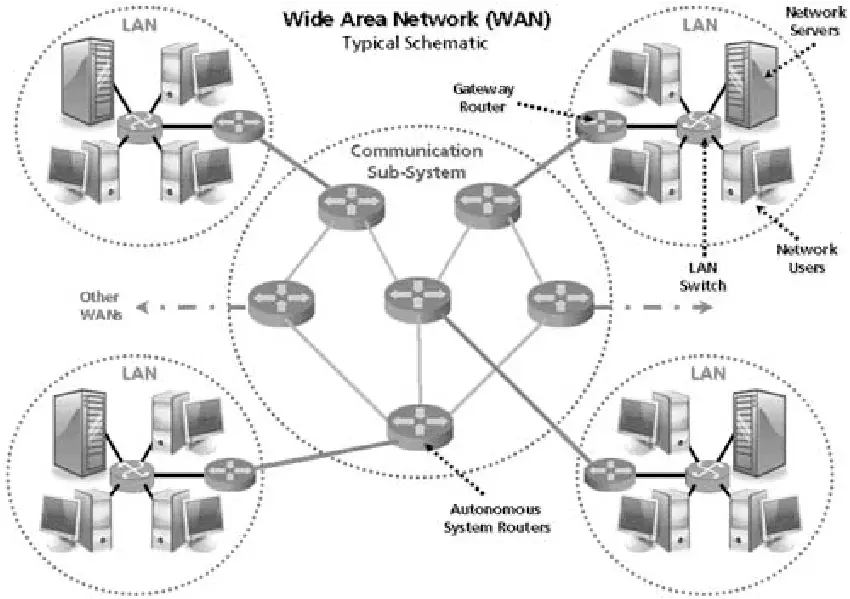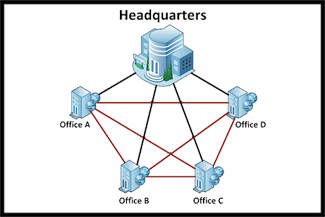A Wide Area Network (WAN) is a telecommunications network that spans a large geographical area, often encompassing cities, countries, or even continents. Unlike Local Area Networks (LANs) that cater to smaller, localized environments like offices or homes, WANs provide the infrastructure necessary for long-distance communication and data exchange.
This article delves into the intricacies of WANs – from their basic components and operational mechanisms to the latest trends and real-world applications. Expect a comprehensive exploration of WAN technologies, their evolution, and their critical role in today’s interconnected world, all presented in an engaging and accessible manner.
Table of Contents:
- What is a Wide Area Network?
- The Evolution and Importance of WANs
- Key Components of a WAN
- How WANs Operate: Technologies and Protocols
- Types of WAN Connections
- WAN vs LAN vs MAN: Understanding the Differences
- The Role of WANs in Cloud Computing
- Security in WANs: Challenges and Solutions
- Future Trends in WAN Technology
- Case Studies: Real-World WAN Implementations
- References

1. What is a Wide Area Network?
A Wide Area Network (WAN) is a telecommunications network that extends over a large geographical area, far surpassing the reach of a local area network (LAN). Designed to connect smaller networks, such as LANs or metropolitan area networks (MANs), WANs enable data exchange across cities, countries, and even continents. They are the backbone of global internet connectivity and corporate networks, making distant communication and data sharing possible.

Crucially, WANs do not belong to a single organization. Instead, they may be leased from telecommunications companies that own and manage these expansive network infrastructures. This leasing arrangement allows businesses and institutions to connect to remote offices, access central corporate resources, or communicate across vast distances without the need to own the entire network.
The architecture of a WAN is complex, often encompassing a multitude of technologies and protocols to ensure efficient and reliable data transmission. These networks typically use routers and public communications links like telephone lines, leased lines, or satellite links, to facilitate long-distance data transfer.

The Internet
While the internet is the most well-known example of a WAN, it’s just one instance of how these networks can be utilized. Enterprises often rely on WANs for internal data exchange between employees and offices located in different regions, making them indispensable for multinational organizations.
Furthermore, WANs have evolved alongside technological advancements. From traditional leased lines and frame relay connections to modern MPLS (Multiprotocol Label Switching) and software-defined WAN (SD-WAN) technologies, they have adapted to meet the growing demand for higher speeds, better security, and more efficient data handling.
In essence, WANs are a vital component of today’s connected world. By allowing disparate networks to communicate over long distances, they have become integral to both global communications and localized business operations, underscoring their significance in the networked age.
2. The Evolution and Importance of WANs
The evolution of Wide Area Networks (WANs) is a testament to humanity’s relentless pursuit of enhanced communication. From primitive telegraph networks in the 19th century to today’s high-speed internet, WANs have undergone a remarkable transformation.
Early Beginnings
The genesis of WANs can be traced back to the telegraph system, which laid the groundwork for long-distance communication. This evolved into the telephone network, expanding the scope and ease of real-time communication.

Digital Revolution
The advent of digital technology marked a pivotal turn in WAN evolution. The introduction of packet-switching networks in the 1960s, a concept integral to the internet, revolutionized data transmission, allowing multiple messages to share the same channel.
Internet Emergence
The birth of the internet in the late 20th century was a watershed moment for WANs. It democratized information access, connecting disparate LANs and MANs into a global network.
21st Century Innovations
The 21st century saw WANs evolve with technologies like MPLS, VPN, and SD-WAN. These innovations addressed growing demands for bandwidth, security, and efficient network management, essential for supporting cloud computing, VoIP, and remote access services.
Importance of WANs
Today, WANs are critical for global commerce, education, and communication. They facilitate international business operations, enable cloud services, and connect remote regions to the digital world. In essence, WANs are the digital bridges that make the global village possible.
3. Key Components of a WAN
A WAN comprises several key components that work together to ensure efficient and reliable data transmission over long distances.

Routers and Switches: Routers are crucial for directing data packets across a WAN, deciding the best paths for data transmission. Switches connect devices within a network and manage data flow, playing a vital role in maintaining network efficiency.
Transmission Media: The physical path for data transfer in a WAN can include copper wires, fiber-optic cables, and wireless links. Each medium has its advantages and limitations in terms of speed, reliability, and cost.
WAN Protocols: Protocols like TCP/IP, MPLS, and PPP are the rules and standards that govern data transmission in WANs. They ensure compatibility and facilitate communication between different network devices.
Network Devices: Devices like modems, firewalls, and VPN concentrators are integral to WANs. Modems convert digital data to analog signals for transmission over telephone lines, while firewalls and VPNs provide security and privacy.
Software: Network management software is essential for monitoring, managing, and troubleshooting WANs. This software helps in optimizing network performance and ensuring security.
4. How WANs Operate: Technologies and Protocols
WANs operate using a combination of technologies and protocols, each contributing to the network’s overall functionality.
Data Transmission Technologies:
- Leased Lines: Provide a dedicated communication channel between two points, ideal for consistent, high-speed data transfer.
- Frame Relay: A cost-effective packet-switching technology that allows for variable data transmission rates.
- MPLS: Enhances data routing using labels, improving speed and efficiency, and is widely used in carrier networks.
- SD-WAN: Software-defined WANs offer flexible control over network traffic, optimizing performance and reliability, especially for cloud-based applications.
Protocols in WAN:
- TCP/IP: The fundamental suite of protocols for internet communication, ensuring reliable data transmission across diverse networks.
- PPP: Point-to-Point Protocol, commonly used for direct connections between network nodes.
- ATM: Asynchronous Transfer Mode, a cell-based switching technique, suitable for both voice and data.
Operational Mechanisms:
- Routing: The process of determining the most efficient path for data packets. Dynamic routing protocols adjust routes based on network traffic and conditions.
- Error Handling: Mechanisms like checksum and retransmission ensure data integrity and reliability during transmission.
- Bandwidth Management: Critical for optimizing network performance, especially in shared or limited-bandwidth scenarios.
By leveraging these technologies and protocols, WANs efficiently manage and transmit data across vast geographical distances, forming the backbone of global communication networks.
5. Types of WAN Connections
WAN connections encompass a diverse range of technologies, each tailored to specific networking needs.
Leased Lines: Offering a dedicated and constant connection, leased lines are ideal for organizations requiring reliable, high-speed communication. They provide a private, secure link between two locations.
DSL (Digital Subscriber Line): Utilizing existing telephone lines, DSL offers a cost-effective way to connect to a WAN. It’s widely used for small businesses and home offices due to its availability and ease of setup.
Cable Internet: This type of connection uses the same infrastructure as cable television. It’s known for higher bandwidth than DSL, making it a popular choice for both residential and business use.
Fiber Optics: Providing extremely high speeds and bandwidth, fiber optic connections are the gold standard for WANs. They are particularly beneficial for data-intensive applications and large-scale corporate networks.
Wireless Connections: Including satellite and cellular networks, wireless connections offer flexibility and reach in areas where wired infrastructure is impractical or unavailable.

MPLS (Multiprotocol Label Switching): MPLS is a sophisticated technique that directs data from one node to the next based on short path labels rather than long network addresses. It’s known for its efficiency and speed.
6. WAN vs LAN vs MAN: Understanding the Differences
Understanding the distinctions between WAN, LAN, and MAN is crucial in the realm of networking.
WAN (Wide Area Network): Spans large geographical areas, often countries or continents. WANs connect multiple smaller networks, like LANs or MANs, and use technologies such as MPLS, leased lines, or satellite communication.
LAN (Local Area Network): Confined to a small area like a building or campus. LANs are characterized by high data transfer rates and low latency. They typically use Ethernet or Wi-Fi technology.
MAN (Metropolitan Area Network): Larger than a LAN but smaller than a WAN, MANs cover a city or a large campus. They are often used to connect several LANs within a geographical area, using technologies like fiber optics or wireless mesh networks.

The primary differences lie in their geographic scope, speed, and the technology used. WANs cover the broadest area, are slower than LANs due to the distances involved, and use a variety of technologies. LANs are the fastest, confined to a small area, and primarily use Ethernet and Wi-Fi. MANs bridge the gap between LANs and WANs, both geographically and in terms of speed.
7. The Role of WANs in Cloud Computing
WANs play an indispensable role in the era of cloud computing.
Connecting to the Cloud: WANs are the highways that connect users and businesses to cloud services. Without WANs, accessing remote servers hosting cloud applications and data would be significantly hindered.
Data Transfer: They facilitate the transfer of large volumes of data to and from cloud services. This capability is essential for businesses relying on cloud storage and SaaS (Software as a Service) platforms.
Hybrid Clouds and Multi-Cloud Strategies: WANs enable hybrid and multi-cloud strategies, allowing organizations to distribute their resources across various cloud environments and their private networks.
Performance and Reliability: The efficiency of WANs directly impacts the performance of cloud services. Advanced WAN technologies like SD-WAN enhance cloud accessibility, offering improved bandwidth management and reduced latency.
Security: As data travels across WANs to reach cloud services, security becomes paramount. WANs incorporate encryption and VPNs to safeguard data transmission, ensuring privacy and compliance with data protection regulations.
In summary, WANs are the backbone of cloud computing, enabling seamless, secure, and efficient interaction with cloud-based resources. Their evolution continues to shape the way businesses and individuals utilize cloud technology.
8. Security in WANs: Challenges and Solutions
In the realm of Wide Area Networks (WANs), security is a paramount concern, given the vast geographical spread and the diverse traffic they handle.
Challenges in WAN Security
- Data Breaches: As WANs transmit sensitive information over long distances, they are prime targets for data breaches.
- Unauthorized Access: The wide accessibility of WANs makes them vulnerable to unauthorized access, potentially leading to data theft or network disruptions.
- Malware and Attacks: WANs are susceptible to various forms of cyberattacks, including malware, ransomware, and DDoS attacks.
- Compliance Issues: Adhering to data protection regulations is a significant challenge, especially for WANs that span multiple jurisdictions.
Solutions for Enhancing WAN Security
- Encryption: Encrypting data in transit protects it from eavesdropping and tampering. Technologies like SSL/TLS and IPsec VPNs are widely used.
- Firewalls and Intrusion Prevention Systems (IPS): Deploying firewalls and IPS at strategic points in a WAN helps in monitoring and controlling incoming and outgoing network traffic.
- Access Control: Implementing robust access control mechanisms ensures that only authorized users and devices can access the network.
- Regular Audits and Monitoring: Continuous monitoring and periodic security audits help in identifying and mitigating vulnerabilities promptly.
- Secure WAN Technologies: Adopting secure WAN technologies like SD-WAN, which offers integrated security features, enhances overall network security.
Addressing these challenges requires a comprehensive security strategy that encompasses both technological solutions and robust policies.
9. Future Trends in WAN Technology
The landscape of WAN technology is continuously evolving, with new trends shaping its future.
Increased Adoption of SD-WAN: Software-Defined Wide Area Networking (SD-WAN) is gaining momentum. Its ability to manage multiple types of connections – from MPLS to broadband to LTE – and its flexibility and cost-effectiveness make it a preferred choice for businesses.
5G Integration: The rollout of 5G promises to revolutionize WANs with higher speeds, lower latency, and improved reliability. 5G will enhance the capabilities of mobile WANs and enable new applications, such as IoT and edge computing.
Edge Computing: As IoT devices proliferate, edge computing will become increasingly important. Processing data closer to the source reduces latency and bandwidth usage, making WANs more efficient.
AI and Machine Learning: The integration of AI and machine learning in WANs will facilitate smarter traffic management, predictive analytics for maintenance, and enhanced security through anomaly detection.
Cloud-Native WANs: The shift towards cloud-native architectures will continue, with WAN services being increasingly delivered through the cloud. This approach offers scalability, flexibility, and seamless integration with cloud services.
Increased Focus on Security: As cyber threats evolve, there will be an increased focus on incorporating advanced security features into WANs, making them more resilient against attacks.
These trends indicate a future where WANs are more agile, intelligent, and secure, playing a critical role in the ever-expanding digital landscape.
10. Case Studies: Real-World WAN Implementations
1. Global Retail Chain WAN Implementation
- Background: A multinational retail corporation required a WAN to connect their hundreds of stores and distribution centers worldwide.
- Solution: They implemented an MPLS-based WAN, integrating different types of connections, including leased lines for critical locations and broadband connections for smaller stores.
- Outcome: This WAN setup ensured reliable, high-speed communication between the headquarters and all locations, facilitating real-time inventory management and sales data analysis.
2. WAN for a Telemedicine Network
- Background: A healthcare organization wanted to offer telemedicine services across rural areas.
- Solution: They deployed a hybrid WAN combining satellite and cellular connections to reach remote areas with limited infrastructure.
- Outcome: The WAN enabled seamless video consultations, remote patient monitoring, and instant access to medical records, significantly improving healthcare delivery in underserved regions.
3. Educational Institution’s WAN Upgrade
- Background: A university needed to upgrade its WAN to support increasing demand for online learning and research collaboration.
- Solution: They adopted a SD-WAN solution, which allowed for intelligent path selection and optimization of bandwidth usage across their campus locations.
- Outcome: The upgrade led to enhanced network performance, better support for cloud-based applications, and a more robust online learning experience for students and faculty.
11. References
- Books:
- “Computer Networks” by Andrew S. Tanenbaum and David J. Wetherall – Provides foundational knowledge on networking concepts, including WANs.
- “WAN Technologies CCNA 4 Companion Guide” by Cisco Networking Academy – Offers an in-depth look at various WAN technologies and their implementations.
- “Data Communications and Networking” by Behrouz A. Forouzan – Covers key aspects of communication systems, including WANs.
- RFCs (Request for Comments):
- RFC 2547 – “BGP/MPLS VPNs”: Describes the use of MPLS in creating scalable VPNs over WAN.
- RFC 2328 – “OSPF Version 2”: Details the OSPF routing protocol often used in large WAN implementations.
- RFC 791 – “Internet Protocol”: Fundamental RFC describing IP, a core protocol in WAN and internet communication.
- Video
- YouTube Video explaining what WAN is (Network Encyclopedia YouTube Channel).